We’re going to cover quite a lot of information under ‘Day 1’ but please bear in mind that many of the areas discussed here will simply be repeated on Day 2, Day 3 and so on. We’re going to cover everything comprehensively in this section, so if you feel like our advice for Day 1 is going on forever, we’re only doing it so we don’t have to mention it again. In essence, make an effort to understand what to do on Day 1 and the rest will easily click into place.
Your glycogen stores should be fully loaded by the time you wake up, but you will have lost some of your liver glycogen during your overnight fast. This can easily be topped up however with a moderately high carbohydrate breakfast. Ordinarily, if this was a 1-day event, you could get away with porridge, regular breakfast cereal or a few slices of toast, but remember, this is multi-day. The decisions you make today will affect you tomorrow – at TORQ, we’ve always used the moto ‘Eat today for tomorrow’ to remind the athletes we talk to that the nutrition they consume today is what stops them having problems tomorrow. Performance in Stage 4 of a multi-day event is going to be heavily influenced by the nutrition consumed in the days preceding it – days in which you will be exercising hard and drawing heavily upon your available resources.
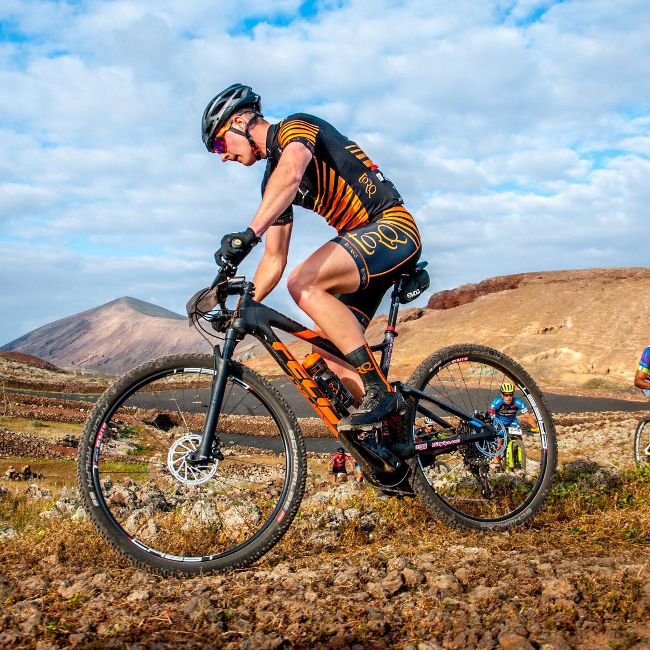
There are 2 vitally important macronutrients to consider during your multi-day events and these are carbohydrate and protein. These two nutrients might have been mentioned a few times already during this article and once the racing starts, the focus on them becomes all the more vital. Carbohydrate is the fuel your body needs to function and protein is essential in servicing your engine – keeping you from falling apart!
The need for protein has already been discussed at length and regular protein consumption on the days you are competing remains the order of the day. The principles are the same, so you should consume 20-25g of high quality protein every 3 to 4 hours to provide the necessary substrate for muscular repair and adaptation. If you don’t stick to these rules, how can you expect your ‘engine’ to be in a healthy state after a few days of competition? You don’t need more than 25g in a single serving, because your body can’t process it, but the 3 to 4 hourly drip-feed optimises the processing of protein by your muscles and means that there is always material available for the repair and adaptation process.
Your breakfast on day 1 therefore should contain 20-25g of protein – your first hit of the day. Add to this a moderate amount of carbohydrate (75g) to top up your liver glycogen and you’re ready for Stage 1.
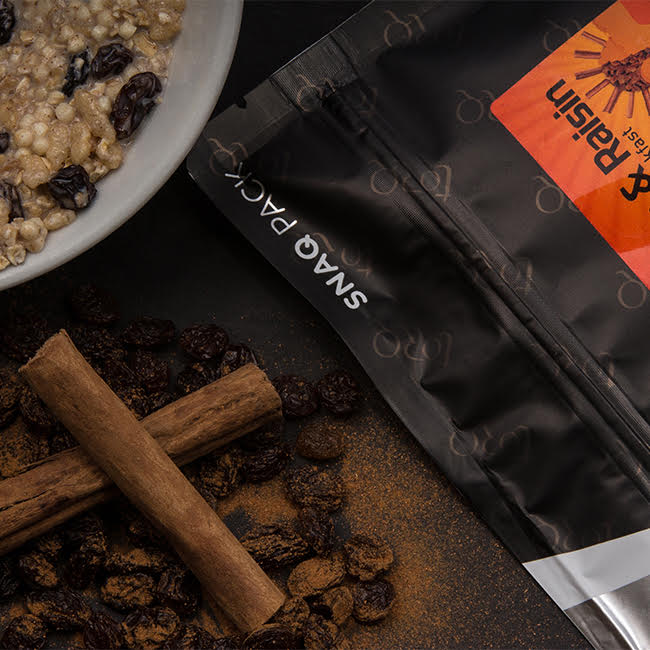
Where do you get 25g of protein from? A tin of baked beans and a couple of slices of toast will give you 20-25g of protein as well as the carbohydrate you need. 3 eggs on toast will give you a similar amount of protein, but also quite a lot of fat, which is less desirable for reasons we will discuss shortly. Half a tin of baked beans on 2 slices of toast with a poached egg might be a good compromise and would give you the 20-25g protein you need. It’s for reasons of cooking logistics and a desire to create an optimal pre-exercise breakfast that lead us at TORQ to develop our 3:1 Instant Breakfasts. These contain 25g of high quality protein and a substantial 75g of carbohydrate delivered from a variety of sources. As demonstrated here at our stage race in Lanzarote recently, they are incredibly easy to prepare with either hot or cold water.
If you’re interested in finding out more information on this product, click HERE. Our instant 3:1 breakfasts are available in Natural Raisin, Cinnamon & Raisin and Banana & Mango flavours.
So, why is fat the enemy first thing in the morning, hours before you compete? Fat has plenty of energy (9kCals per gram compared with 4kCals per gram for protein and carbohydrate) but it’s not a calorie we need. Our bodies store plenty of fat and it’s just as easy for us to mobilise this fat to burn as a fuel from our bodily stores as it is to get it directly from the food we eat. Also, any carbohydrate or protein calories we consume in excess is stored as fat anyway, so there’s a logical argument to say that the calories you should be focussing on should be the ones that are ultimately going to be useful – better to store an excess of useful calories than provide a calorie that has no obvious purpose other than to be stored. Fat does contain the fat-soluble vitamins A, D, E and K as well as essential omega oils, so it certainly shouldn’t be outlawed, but there’s a time and a place and prior to, during or immediately after exercise are not the right times to consume fat. Fat blocks the absorption of carbohydrate and protein due to its slow passage through the digestive system. Your breakfast first thing in the morning before you exercise needs to be low fat, moderate to high carbohydrate and with 20-25g of high quality protein. This will be absorbed quickly and efficiently, leaving your digestive system clean and ready to accept the during-event fuelling you’re going to throw at it. We’ve written previously on Nutritional Health and you should take the time to take on board our perspective on what we feel constitutes a healthy diet. Click HERE to read more – it’s pragmatic and sensible. Fat certainly has its place in your diet, but timing is critical, especially during events like this.
You’re on the start line with 5 minutes before kick-off. Take an energy gel. This is the start of your during-race fuelling. It’s important to understand the difference between how your body burns your glycogen stores, which you’ve worked incredibly hard to load-up prior to the event and the fuel you take on board through energy gels, drinks and bars during the race itself. Stored glycogen (called ‘Endogenous’ carbohydrate) is released as a fuel source during exercise, but the more ‘Exogenous’ carbohydrate (carbohydrate from energy products) you consume, the less endogenous stored carbohydrate you need to release. We could write a number of paragraphs explaining this process, but it is much more easily explained through a video. See below:
Hopefully the video explains clearly, the interplay between endogenous and exogenous carbohydrate. The more you fuel, the faster you can ‘afford’ to go and the better you preserve your endogenous stores. In stage racing, looking after your endogenous stores is critical. You’ve prepared perfectly and gone into this race with fully loaded stores. You must now do everything in your power to protect them and during the event and this means consuming the maximum amount of carbohydrate your body is capable of absorbing and using.
The video explains how absorbing and using 90g of carbohydrate per hour is only possible if the products are formulated using 2:1 Glucose Derivatives:Fructose, called ‘multiple-transportable carbohydrates’, which all TORQ products are. The video demonstrates that you will get benefit from consuming 30g per hour and 60g per hour, but for all the reasons mentioned so far, it’s obvious how 90g per hour offers further advantages, particularly in stage racing. You can use any low fat, high carbohydrate foods and drinks to fuel with, but don’t expect them to sit comfortably on your stomach and don’t for a moment think that you will be able to consume and use 90g of carbohydrate per hour from them.
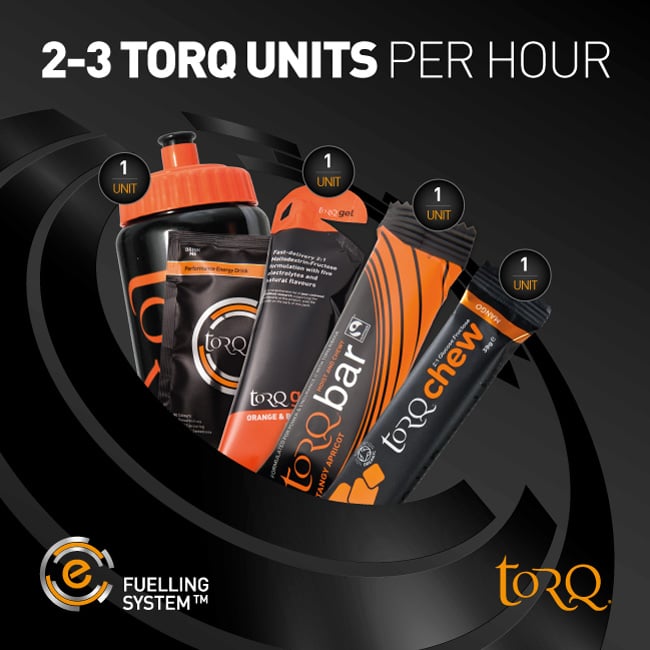
The research has been extensive and there are over 20 peer-reviewed published studies listed at the end of this article supporting the specific benefits provided by 2:1 formulations – these blends need to be formulated specifically and don’t occur randomly in nature or within confectionary factories! Even if you’re not planning on fuelling on 90g carbohydrate per hour, you’re still better off consuming 60g per hour from a 2:1 formulation like TORQ and being comfortably 30g below your absorption threshold than being ‘on the absorption limit’ with glucose/sucrose based products. Gastro-intestinal comfort should be very high on your list of priorities at all times and certainly during a multi-day event. Fuelling doesn’t need to be unpleasant, which is why TORQ’s products have such interesting and diverse flavour profiles. Click HERE to take a look at our 2:1 Energy Gels for instance – flavours range from Black Cherry Yoghurt and Lemon Drizzle through to Rhubarb & Custard, Apple Crumble and Raspberry Ripple. Enjoy the fuelling experience and consume products that deliver energy properly and won’t upset your stomach.
How should you be getting your carbohydrate into your body, through a drink, gels, bars or chews? It’s for the obvious confusion generated by the vast array of different energy products on the market that we created the TORQ Fuelling System. All TORQ products contain 30g of carbohydrate, whether 500ml of Energy Drink, an Energy Gel, an Energy Bar or an Energy Chew, so all will deliver the same energy – which product you choose will come down to your hydration needs and your textural desires. Take a look at this short video, which explains our system very succinctly:
Notice how your fuelling intake should remain constant irrespective of perspiration rates, but when conditions are warmer and perspiration rates are higher, more of your carbohydrate should be delivered through your drink. By the same token, if perspiration rates are lower, you should be leaning more towards eating your concentrated carbohydrate units and drinking less. The diagram below sums this up quite nicely:
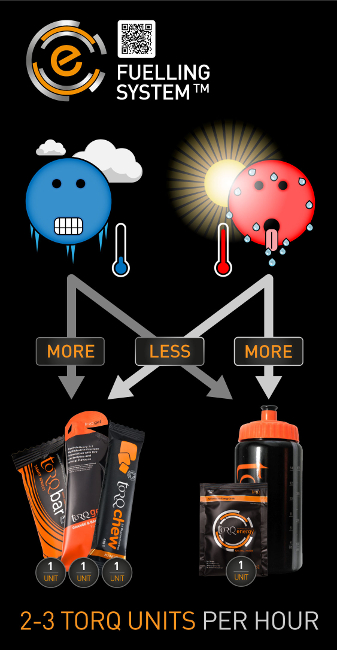
The length of the individual stage will have a significant impact on whether you need a 25g protein feed during the stage too. Typically, for any stage up to 4 hours long, you won’t need to consume protein – any benefits you might gain in the long-term will be outweighed by decreased carbohydrate uptake (protein intake will slow the absorption of carbohydrate). However, if the stages are much longer than 4 hours, you really should be looking at taking on a protein feed after 4 hours. For instance, if the stage is 8 hours long, you should be taking on board 25g of protein at around 4 hours and then immediately at the end in the form of a recovery drink, with carbohydrate. If your multi-day event isn’t necessarily an organised race (perhaps a training camp or point-to-point like LEJOG) you may be exercising for long periods of time during the day, in which case you should make sure you consider protein intake. Our recent trip to Lanzarote had stages that lasted (depending on ability) 1.5 to 2.5 hours (D1), 2.5 to 3.5 hours (D2), 1 to 2 hours (D3) and 3.5 to 6 hours (D4), so the only stage that was long enough to consider protein feeding was on the final day and since there wasn’t a stage on Day 5, what possible advantage could have been gained? The ‘Eat today for tomorrow’ motto doesn’t apply when you don’t have any exertion to do the following day. The same argument could be applied to single-day ultra-endurance events in that the negative impact protein intake has on the carbohydrate fuelling process would outweigh any benefit it would bring to your performance. On single-day events, you might feel more fatigued the day afterwards by missing out on protein, but that doesn’t matter if your performance on race day was better for having a consistent uninterrupted 90g per hour carbohydrate per hour fuelling protocol. As a rule, avoid protein intake during exercise unless there are multiple stages are they are particularly long and arduous.
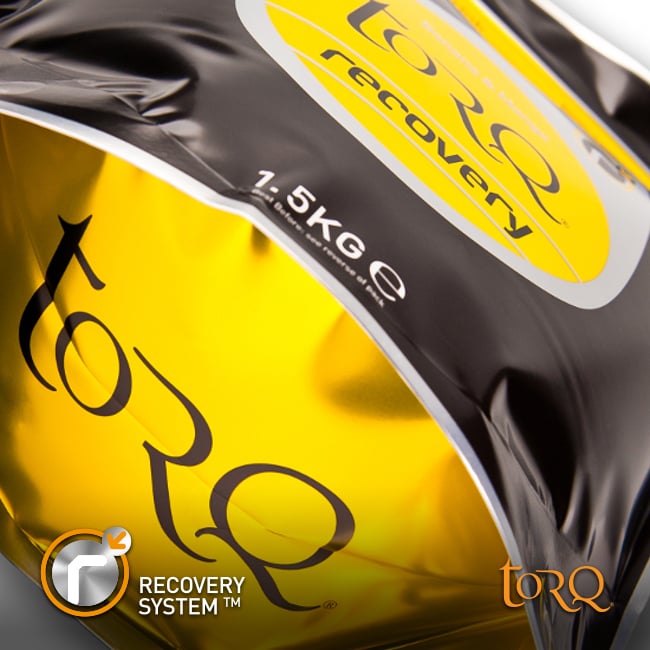
Consuming a recovery drink immediately after the stage is essential as this not only delivers a desperately needed 20-25g of high quality protein, but also a large dose of carbohydrate to help restock your endogenous glycogen stores. For the same reasons mentioned during the carbohydrate loading phase, for a short window of time after exercise, muscle enzyme activity (glycogen synthetase) is elevated and this really assists with the glycogen storage process. Use a recovery drink that contains 3 parts carbohydrate to 1 part protein. Whey protein is the quickest acting and most effective for post-exercise recovery, which is why we use it in our TORQ Recovery Drink. If you are vegan, pea protein is the best and quickest-acting protein source to use and you might want to consider TORQ’s 3:1 Vegan Recovery drink. Our whey protein based recovery drinks are pre-flavoured and taste like a thick milkshake, whereas our Vegan Recovery formula needs to be added to 400ml of Oat Milk or Orange Juice. We have taken account of the nutritionals within the Oat Milk and Orange Juice and have produced 2 different powder blends, so as long as you add the correct blend to the correct fluid, this vegan product will be 3:1 Carbohydrate:Protein.
Take a shower, get into some comfortable chill-out clothes and graze on some fruit and high carb snacks whilst you’re preparing a meal. We wouldn’t usually advocate eating sweets like wine gums and fruit pastels as part of a healthy balanced diet, but this situation is unusual and different. You need to keep the carbohydrate going in to re-stock those endogenous glycogen stores and although fruit should be consumed, because it is richly infused with important micronutrients, fibre and water, trying to get all of the carbohydrate back into your liver and muscles without a bit of help from some concentrated carbohydrate sources like sweets is going to be impossible. Often dubbed ‘empty calories’ because they contain nothing but carbohydrate, it’s for this reason that they can play an important role in assisting recovery after exercise.
We mentioned earlier about the use of TORQ Energy Organic too. If you don’t like the idea of eating sweets, make a cup of tea or coffee and add a few scoops to it, or add a few scoops to a glass of fresh fruit juice. Other high fat low carb items that you might want to have to hand could include low fat cereal bars. The TORQ Bar is designed for energy delivery during exercise, but it makes an equally wholesome low fat high carb snack to enjoy with a cup of tea. If you can find a supply of low fat cereal bars in your local supermarket, they’ll work fine too, just make sure they don’t contain artificial sweeteners – you need the sugar remember – it’s carbohydrate. Savoury snacks like pretzels are low in fat and high in carbs too, so go to your supermarket, look at the labels and pick up a variety of foods to graze on. One of our riders in Lanzarote took to bowls of cereal and had a bit of a fetish for low fat tinned rice pudding. It’s all good – add some honey or a blob of jam too and get the carbs in. Hopefully you get the idea? Fat is the enemy though remember? It will slow down your digestion and stop you feeling hungry. You’ll know if you’re eating the right things, because you’ll keep getting hungry and wanting more. Finally, on the subject of grazing, remember to consume plenty of fluid so that you store this carbohydrate. It takes care of itself really through the thirst reflex, but there’s no harm in making sure you’ve got a pint of water on the go at all times.
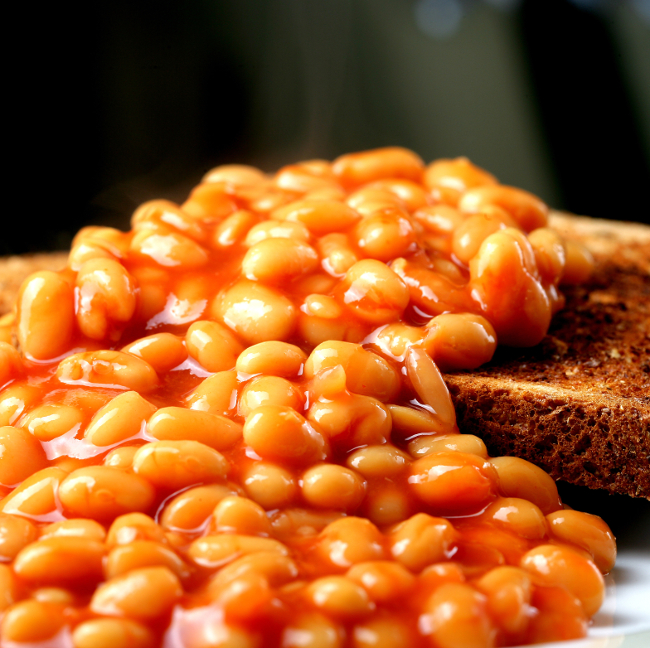
For your first meal after exercise, make sure it has the magic 20-25g of high quality protein in it as well as being high carbohydrate. You can start to be a bit more relaxed about fat intake now, but you should still be keeping all of your food, except the last meal of the day low in fat to facilitate the absorption of protein and carbohydrate. You could have beans on toast again, if you want something quick, but make sure you have a full can of beans this time. Pasta or rice based dishes with a low fat sauce are ideal too. As previously mentioned, TORQ do produce meals and breakfasts that are specifically designed for these kinds of events. We wouldn’t for a moment suggest that you need them or that they are in any way optimal at this point in the day, but they can form a useful and convenient part of your overall nutrition strategy, which is why we formulated them. Whether you consume one of our meals as your first meal after exercise, or later on in the day, just fit it in where it suits.
TORQ products are there to assist performance and of course you could probably quite easily rustle up your own high carbohydrate dish with 25g of protein in, but if we can make it easy for you by sticking natural ingredients in one packet, which can be decanted into boiling water and popped in the microwave for 15 minutes whilst you’re showering, then that’s the idea. The quick video clip below shows how easy our pasta meals are to make:
We have 3 nutritional profiles for our meals, 2:1, 3:1 and 5:1 Carbohydrate:Protein. Go for either the 3:1 or 5:1. The 5:1 is a bigger meal and contains more carbohydrate, but the 3:1 will work well too. At the end of the day, if you’re still hungry after you’ve had a 3:1 meal, you can always eat some fruit or graze on other high carb snacks. For further information on the full range of our optimised pasta meals, click HERE.
For the rest of the day, stick to the rules we discussed before and make sure that you continue to take onboard 20-25g of protein every 3 to 4 hours and graze constantly on fruit and high carbohydrate snacks. For your last meal of the evening, go for something rice or pasta based to get the carbohydrate in – again one of our 5:1 meals would work well if logistically it’s difficult to prepare a meal. Have a desert too and this is the time of day where you can be a even more relaxed about your fat intake. Don’t consume fat unnecessarily, but at the end of the day (literally), you’re going to be going to bed and sleeping, so you’ll have the whole night to digest your food.
Remember TORQ Energy Organic, the ‘invisible calorie’. If at any point you’re struggling to get the carbohydrate calories in, use this product. You might not want to eat anything more, but you’ll easily be able to drink half a pint of fruit juice laced with this magical white powder!






